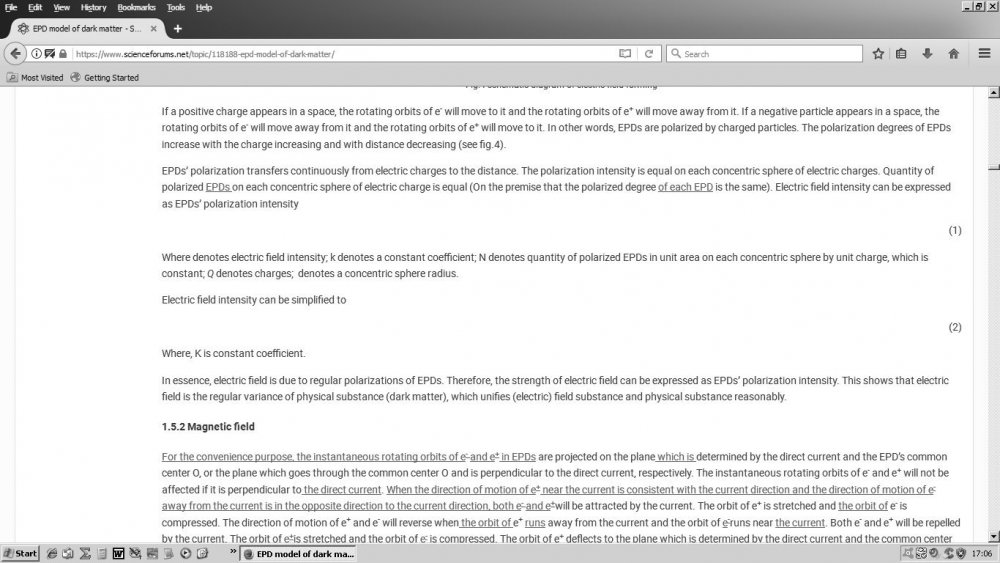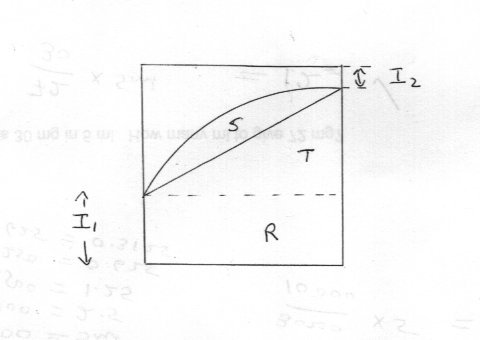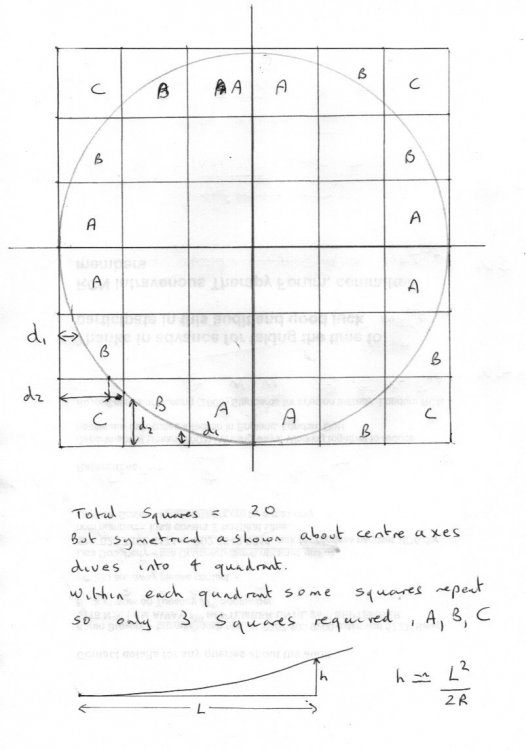-
Posts
18311 -
Joined
-
Last visited
-
Days Won
104
Content Type
Profiles
Forums
Events
Everything posted by studiot
-

Elucubrations on positve, negative & imaginary numbers
studiot replied to michel123456's topic in Speculations
Although you seem to have stopped bothering with my offerings, I suggest you think more deeply here. The product of Force x Distance is a grand counterexample to both your thoughts. Force times parallel distance gives work or energy. Force times perpendicular distance gives moment or leverage. A compartmented box of 6 oranges x 10 oranges does not contain 60 square oranges (Have you ever seen a square orange?) It contains 60 oranges. Edit I will leave it to Eise to explain why (2 + i)(5 - 3i) does not give you an area, but another complex number. (2 + i)(5 - 3i) = (10 + 5i -6i -3i2) = (13 - i) -
I notice neither of you staff members offered a welcome to a new member, keen to study some real science. I presume you would prefer to start a professed beginner off on something like this. http://www.hartismere.com/cBNbMkzHY5.pdf
-
Well you haven't siad what f(p) is and I don't know why you have separated p from f(p), since phi (p) is still a function of p alone and makes the ODE autonomous. Here is a simple explanation of what is a single autonomous ODE https://sites.math.washington.edu/~aloveles/Math307Spring2016/m307Review2-5.pdf Here is some stuff about solving pairs of them https://math.stackexchange.com/questions/1405497/solving-a-pair-of-odes?rq=1
-
So would this be a pair of autonomous equations with [math]\varphi \left( p \right) = p - f\left( p \right)[/math]
-
Funny how people have been looking out at the heavens through glass for centuries. Some of them have been into space and done this. Reported for trolling.
-
Ryan, welcome to ScienceForums. Since you have come forward like this I am going to say +1 for encouragement, but you need to be more focused here, like swansont says. In relation to your topic, here are a few hints. Although your topic is in Chemistry, you will need to equip yourself more widely with basic Science, particularly Physics. You will need to know the difference between force and energy, and the different types of energy, particularly potential energy. You also need to have an idea what a particle is. You will also need to know the meanings of the terms atoms, molecules, ions, elements, compounds, pure substances and mixtures. Chemistry is very theoretical. It tends to concentrate on substances the ordinary person does not come into daily contact with and cannot readily obtain, eg nitrogen and oxygen. Seeing that your work in hardware, you may find the more down to earth approach used in Materials Science or Engineering Science attractive. Here the emphasis would be more likely on air in my example. So hardware means things like glue and timber and concrete and rope and so on. Chemists will discuss the forces between individual oxygen atoms - very theoretical. materials Scientist will be more interested in why and how the fibres in a rope hang together to form a length of rope, even though no individual fibre is anywhere near as long as the rope. If any of this gives you inspiration for more questions, I will have achieved my objective.
-

The nature of time ( question).
studiot replied to Elendirs's topic in Modern and Theoretical Physics
Well I think information can be lost and the circumstances under which it is preserved are somewhat limited. Memory. It is all too easy to assign some sentient connection to a natural process. So you could ask does the river have a memory of where to flow or, ? How does the water know which way to flow in the channel ?. But aren't we wandering off topic and shouldn't this be a separate thread? -

Infinitesimals and limits are the same thing
studiot replied to dasnulium's topic in Analysis and Calculus
I don't seem to have had an answer to this post I don't agree with this. Examples from statistics come to mind. Whilst I liked the style and presentation of your paper, I don't endorse everything in it. A further comment One thing you don't seem to have examined is the clear difference between infinitesimals and limits. Limits allows one to step over the process of accounting for an infinity of terms, which you correctly say begs the question of do the ignored terms add up to something significant, and go directly the an end result, or show that there isn't one. Convergence theory is all about this. I do not know of any equivalent process with infinitesimals, NSA notwithstanding. -
Would this be homework? I don't have the Henry's law coefficients for 25oC, only for 20oC. These are For oxygen 2.95 x 107 mm For nitrogen 5.75 x 107 mm Do you have the 25oC ones?
-
If you have provided any formulae at at, they have not appeared here. This is all I can see on my screen. Perhaps you wrote them in dark ink?
-
Thank you. I thought the forum enforced its own default font. It always changes mine if I cut and paste in from a word processor. I don't see any attempt to mathematically answer my mathematical question. I don't see any attempt to answer swansont's mathematical question about how a positron-electron pair can be in such a state that it possesses a dipole moment. All I do see is a long litany of extraneous and irrelevant material. I only bothered with this thread because it is just possible that someone has come up with a bound state that we don't know about which has a lifetime of better than 100 nanoseconds. Properly stable positrons could be really useful if we could find a way to make them. Equally I can't make any connection between your proposed bound state and dark matter or dark energy. By definition dark matter and dark energy do not interact with conventional matter and energy in the ways you are proposing, either by oscillation or otherwise. Your bound state would be a tremendous breakthrough all by itself, dark matter and dark energy aside, if we could find such a state. But sadly I remain very doubtful.
-
2 EPD model self-verification delusion.
-
What are the funny little squares incorporated in your text. They are not English so am I missing something? OK so your answer is that the experimentally confirmed equation hv = 2mec2 + E1+ E2 Where h is planck's constant, v is produced radiation frequency, me is the mass of the electron/positron E1 and E2 are the kinetic energies of the particles (positron and electron) is incorrect? Or perhaps you just haven't bothered to look up any of the many particle physics experiments I referred to? Yes I agree this is not a discussion it is a preaching session.
-
An electron-positron dipole huh? Well others before you have investigated the possibility of a stable combination of an electron and a positron. There is a type of atom called positronium with no nucleus, just an electron positron pair so the atomic number is zero, and the atomic mass is 2me. The electron pair exist in the lowest S orbital state with opposite spins. The problem here is stability. Experimental work by Deutsch confirmed the lifetime of such positronium atoms to be about 1.5 x 10-7 seconds. Earlier work both theoretical (Crane) and experimental (Dumond) had established the realtionship between EM radiation (gamma rays) and electron positron pairs. Again a time constant of the order of 10-7 seconds was involved. So a link between electron-positron pairs and high frequency EM radiation is well established Now your problem is to show how your electron-positron pair is fully stable. I say fully because Dark Matter is called Dark because it is well, dark. That is there is no EM radiation at all. Since there is supposed to be significant amounts of this stuff, extending over significantly large regions of space and long periods of time, an electron-positron pair must be in an incredibly stable configuration to never produce any gamma rays. Please explain how you model is consistent with both these experimantally observed and theoretically derived facts?
-
I should perhaps add how to get the areas? Well in each square you have to add the area of a rectangle R, a triangle T and a circular segement S. You already have the circle radius and can easily find the chord length as the hypotenuse of a right angled triangle. So these are easily calculable from the intercepts, or you can use an online calculator for the segments. You haven't stated your mesh size, but with the size shown in the drawing you only need three sizes and to find these you only need two intercepts. Symmetry does the rest.
-

The nature of time ( question).
studiot replied to Elendirs's topic in Modern and Theoretical Physics
Both. A shadow is the absence of something (light, sound, rain....) For most things this means zero as you generally can't have negative amounts. Stasis is the absence of movement. You wouldn't want your buildings to move would you? So the Science of mechanical statics is employed. -

The nature of time ( question).
studiot replied to Elendirs's topic in Modern and Theoretical Physics
I gave an example of zero, right after I said that. -

Elucubrations on positve, negative & imaginary numbers
studiot replied to michel123456's topic in Speculations
Is the dot product or the cross product of co-planar vectors a vector in the same plane? Is the product of one complex number with another, yet another complex number? You mentioned symmetry a while back. There is an interesting application of symmetry in this thread. Perhaps you can think of something better? -
Here are some thoughts. Use symmetry. That substantially reduces the workload. Then you can calculate the coordinates of the intercepts with the sides of the squares by calculating the offsets from the tangent. The four sides of the outer box are tangent to the circle as shown. The simple formula for perpendicular offsets from the tangent to a circular curve is Offset = (Length along the tangent)2 / twice radius
-

The nature of time ( question).
studiot replied to Elendirs's topic in Modern and Theoretical Physics
What is a shadow made of? Shadows certainly 'exist' - whatever that means. A shadow is a prime example of zero something. I think the english language offers a good construction. it = a thing is a noun. Nouns can be 'concrete nouns' like an apple or water or well, concrete. Or nouns can be abstract nouns like anger, a shadow, weight and so on. -

Elucubrations on positve, negative & imaginary numbers
studiot replied to michel123456's topic in Speculations
Yes, and funnily enough my pigeonholing was approaching this from a different direction. But the vectors of Q2 or R2 are not the planar geometric vectors Eise and I were talking about. These do not form a field as they do not satisfy the field axiom (not the non existant vector space axiom) of completeness under multiplication. -

The nature of time ( question).
studiot replied to Elendirs's topic in Modern and Theoretical Physics
Lot's of folks have these sorts of misgivings at some time or other. I am only going to comment upon one thing you said , for now. The ancient Greeks discovered a lot of Mathematics and Science. But they did not know about zero and (although they did not realise this) it was a great hindrance to them. Zero is very important to modern Mathematics and even more important to Science in general. Partly as a result of not understanding zero, the ancient Greeks had many philosophical difficulties which the expressed as paradoxes. The most famous are Zenos paradoxes So don't throw out zero time duration or zero events in a non zero time duration. The Science of stasis or statics is very important in our world. -
I realised that I was wrong and corrected it in the rest of this post
-
There is something fundamentally wrong with this statement. 'change it' implies something rather startling. It implies that 'it' is one thing and then something else after the change. This further implies that you know both the before and after. How do you know the before if you don't measure? And if you don't know because you haven't measured, how do you know it has been changed? I am using before and after to mean before and after the change. Heisenberg's original work was in terms of matrix representation. The unvcertainty principle is inherent in matrix multiplication, which is how he found it. The maths of this is cut and dried, and was then. There were no shortcomings, although the principle was so radical it confused many, even its originator at times.





